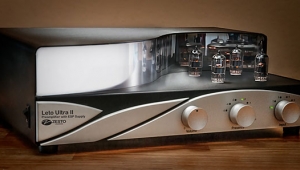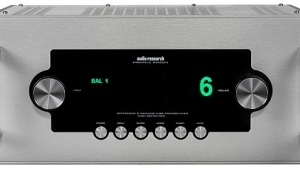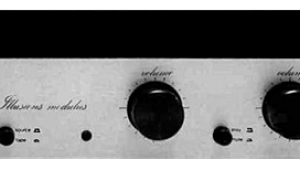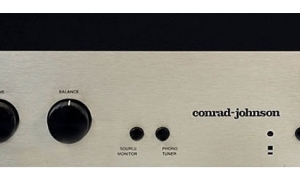| Columns Retired Columns & Blogs |
Nagra PL-L preamplifier
Unpacking and installing a new component is always cause for excitement, even if one does it with almost mechanical regularity, and the anticipation is greater when the component is from a manufacturer of almost mythic reputation. So when John Atkinson asked if I'd like to audition Nagra's new PL-L preamplifier, I feigned calm as I accepted the assignment, even while remembering those years in college radio when I had to schlepp big Ampexes and Maggies. The sexy, portable Nagras were the stuff of dreams. Finally, I thought, I'd get my hands and ears on one.

But this line-level preamp without phono stage made me think about what, in this age of digital sources and standalone phono stages, is a preamp's fundamental role. Well, as one can see from the popularity of so-called "passive" preamps, that true function is the attenuation and adjustment of the signal level and, usually, the selection of signal source. Yet today's preamp market encompasses everything from the bone-simple EVS attenuators to the open-ended complexity of the modular preamps from Meridian, Boulder, and Viola Audio Laboratories.
The compact Nagra PL-L is sort of in the middle, and far from the elaborate end of the spectrum. While it's nominally a consumer product, the PL-L reeks of Nagra's professional heritage: It's a very tidy box with inputs on one side of its front panel, outputs on the other, and three basic controls: volume, balance, and input selector. Even including its separate power-supply brick, it's smaller than any preamp I'd ever used, and downright minuscule in comparison to my reference Sonic Frontiers Line-3.
However, you'd be wrong to assume that the PL-L is functionally compromised in comparison to most larger preamps. First, it has four inputs, three outputs, an extremely informative level meter, and a full-function remote control that will, I'm told, be able to operate many other Nagra components in the near future. Second, the PL-L is built in the Nagra tradition, which successfully bridges hand- and eye-pleasing design with no-nonsense professional solidity. For example, the aging of the three tubes is monitored by a usage timer on the circuit board. Third, it sounds...well, I'm getting to that.
The input jacks are on the left side of the chassis rather than the rear. While inputs B, C, and D are single-ended RCAs, A is a pair of single-ended XLRs in which pin 2 is hot and pins 1 and 3 are grounded. Connection of a balanced source (or an unbalanced one with pin 2 hot) will work fine, but, depending on whether the balanced source uses the American/IEC or the Japanese convention for XLR wiring, you'll get one polarity or the other. The PL-L doesn't include a polarity switch, and, since absolute polarity of program sources is unpredictable, you can count on getting absolute polarity right only about 50% of the time. On the other hand, that's no better or worse than with any device of fixed polarity. There's also a sturdy ground post on this side panel.
The selectable output jacks are on the right side panel of the chassis. Output 1 consists of two stereo pairs of RCA jacks, available simultaneously. Output 2 is a pair of XLRs that can be unbalanced, like the XLR input, or fully balanced and floating with the optional output transformers. Also on the right side are the LEMO socket for the power-supply umbilical, which supplies 12V to the PL-L. The hefty power supply runs pretty warm; be careful where you hide it.
The front panel, from left to right, has the input, volume, and balance knobs. The input selector has a power Off position and, if one turns it to the setting just beyond Input D, a position that enables the remote control to select input and power On/Off. In the other input positions, the remote controls only volume and balance. To the right of center is the Nagra Modulometer, a level meter whose independent left- and right-channel indicators have a ballistic response that permits the user to see the correct magnitude of signals, regardless of their duration. This is particularly useful for assessing brief, spike-like events. To the meter's right is a small toggle that turns the meter lamp on or off or, in its spring-return third position, sets the meter to indicate the power-supply voltage. Next to that is another toggle to select between outputs, with Mute in the intermediate position. The remote control's receiver and indicator are at the extreme right end of the panel.
Inputs on the left, outputs on the right, controls on the front—doesn't that sound like the ever-fastidious Swiss? And on the back? Nada. But wouldn't you know it—my sources are all to the right of the preamp on my double rack, and my power amps are all on the other end of the room, to the left. I thought, briefly, about turning the PL-L upside down, but concerns about cutting off ventilation to the tubes stopped that. I also mused about Nagra offering both and recto and verso versions of the PL-L, but quickly recognized the folly of that as well. So, in my setup, the input and output interconnects crossed paths behind the PL-L. No problems resulted.
I tend to leave my solid-state power amps on all the time, and so far, the preamps I've used have been well-behaved enough—with few or no on/off transients, whether by design or by my use of muting—to let me get away with this. The PL-L, however, made two noises: a small pop on turn-on, and, after a prescribed 15-second mute, another pop, the magnitude of which could be disturbing at my normal volume setting. The problem was that I tended to use power Off rather than the well-behaved Mute control, because 1) it's more prominent on the front panel, 2) it's more boldly labeled and attractive on the remote, and 3) I know that tubes have finite life spans.
- Log in or register to post comments




































